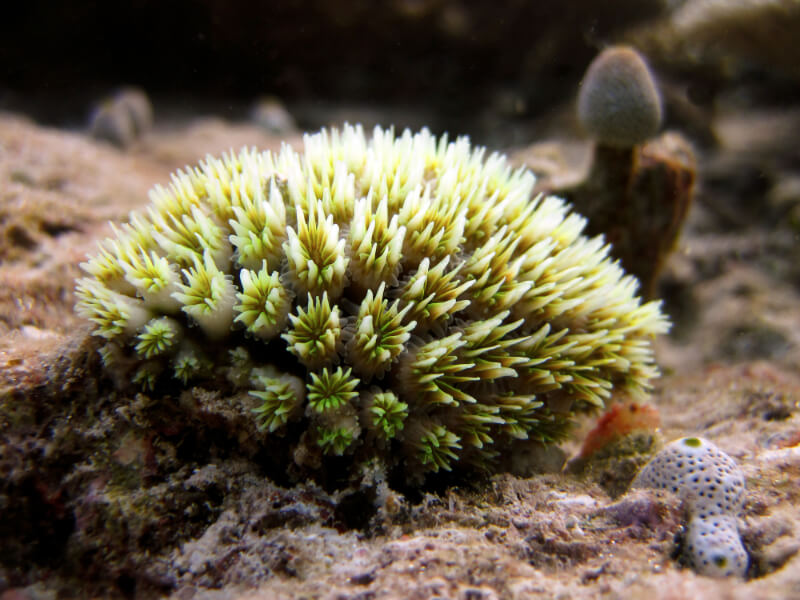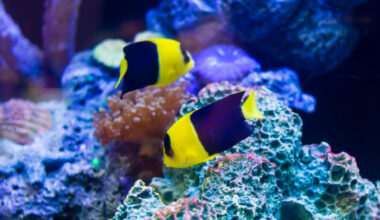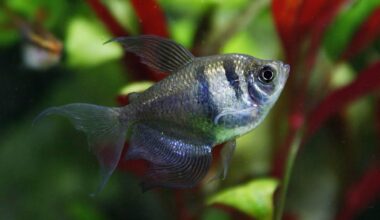
Welcome to the space coral! Sorry, I mean the Galaxea coral! This beauty of the saltwater world is known for its aesthetic resemblance to the stars. Don’t let its good looks fool you since they are quite aggressive and have a few specific requirements to ensure a peaceful aquarium.
The benefits of corals in your tank is that they are not as delicate as many fish so you will be able to improve the appearance of your saltwater paradise without too much work (as long as you choose the proper tankmates).
This guide may not teach you about planets, but you will learn a lot about successfully caring for your Galaxea coral. Let’s dive in!
Quick Facts 
| Scientific Name: | Galaxea fascicularis |
| Other Names: | Tooth coral, Galaxy coral, Star coral, Crystal coral, Starburst coral, Brittle coral, Galaxy coral, Scalpel coral, Durian coral |
| Water Flow: | Moderate, 20 to 40 times water turnover |
| Compatibility: | Blennies, Clownfish, Damselfish, Dartfish, Jawfish, Wrasses, Puffers |
| Size & Growth: | Polyps can reach 6mm in diameter |
| Care Level: | Intermediate |
| Feeding: | Meaty Foods: Finely chopped seafood, such as shrimp or fish |
| Water Parameters: | 75-82 F, 8.1-8.4 pH, 1.023-1.-25 SG, 8-12 dKH, Calcium 380-450 ppm, Phospage <0.05ppm, Ntrate <20ppm. |
| Tank Size: | 50 gallons |
| Lighting: | Moderate with 100-200 PAR |
| Propagation & Fragging: | Medium difficulty. They are fragile so use a bone cutter or a frag saw and attach the fragment to a rock or a ledge far away from other corals. |
Table of Contents
Species Summary
The Galaxea fascicularis (scientific name), commonly referred to as Galaxy coral, Tooth coral or Starbust coral, is a stony coral known for its unique appearance and aggressive nature. Native to the Indo-Pacific region, this species is admired for its intense coloration and challenging care.
When considering Galaxea for an aquarium, it’s essential to note that they possess sweeper tentacles that at night can extend up to twenty times, reaching 6 to 12 inches, contributing to their aggressive temperament when defending space.
Endowed with both stunning beauty and a formidable presence, Galaxea Corals add a striking element to marine aquariums, provided their specific care requirements are met to ensure a healthy and thriving environment.
Appearance
Galaxea Coral is recognized for its distinctive and expressive appearance. You will notice that it exhibits a variety of vibrant colors including green, purple, and blue. The polyps of this coral possess long, slender tentacles that can extend well beyond their base, giving the coral a fuzzy and bristled look, especially when fully extended.
In particular, Galaxea Coral tentacles often have contrasting white tips, which can add a striking visual effect to the coral’s overall appearance. Here are some notable features:
Tentacles: Typically long with potential for extended reach.
Colors: Ranges from green and purple to blue with the possibility of other hues.
White Tips: Many of the tentacles feature prominent white tips.
When caring for Galaxea Corals in home aquariums, owners enjoy their dynamic and textured presentation, which can serve as a captivating focal point.
Author Note: It’s vital for us to consider their aggressive growth patterns, as their appearance can change based on their surrounding environment and the space they have to expand.
The tentacles’ pulsating movement contributes to its unique and lively aesthetic, reinforcing why we regard Galaxea Corals as a visually engaging species in the marine aquarium hobby.
Popular Galaxea Coral Species
When it comes to maintaining a vibrant reef aquarium, the inclusion of Galaxea corals is a favored choice among enthusiasts. As specialists in the care of marine invertebrates, we’ve observed several sought-after species that exhibit both aesthetic appeal and adaptability to captive conditions.
- Galaxea fascicularis, commonly referred to as the Galaxy Coral or Tooth Coral, stands out as the predominant species in the Galaxea genus. It is famous for its star-like polyps and crystalline texture. What makes it appealing is its wide color palette, ranging from shades of green and brown to more exotic hues.
- The Battlestar Galaxea deserves a notable mention for its unique appearance. It exhibits a dynamic color contrast that can be spectacular under the right aquarium lighting conditions. Their polyps have a remarkable ability to catch light, creating a glistening effect that resembles a starry night sky.
- In the more premium spectrum, the Gold Galaxea Coral garners attention for its rare and exquisite golden polyps. Due to its unique coloration, it’s highly prized by coral collectors and often seen as a centerpiece in many reef tanks.
We emphasize that these species can be aggressive and possess extended sweeper tentacles. These are used to sting and keep competing corals at bay. Therefore, it’s crucial to provide sufficient space for each specimen in the aquarium to flourish and prevent altercations with other inhabitants.
Galaxea Coral Care
Caring for Galaxea coral involves specific requirements for tank size, water parameters, tank setup, and acclimation to ensure a thriving environment. Our guide provides a straightforward approach to maintain the health and growth of your Galaxea coral.
Tank Size
For Galaxea coral, a minimum tank size of 50 gallons is recommended due to their aggressive nature. While they may not need an entire galaxy, they do require ample space to expand without contacting other corals, as they may engage in chemical warfare with their neighbors.
Water Parameters
Proper water parameters are crucial for Galaxea coral health. Aim to maintain the following levels:
- Water Temperature: 75-82°F (24-28°C)
- pH Levels: 8.1-8.4
- Specific Gravity (Salinity): 1.023-1.025
- Alkalinity: 8-12 dKH
- Calcium: 380-450 ppm
- Magnesium: 1250-1350 ppm
- Phosphate: <0.05 ppm
- Nitrate: <20 ppm
Conduct regular tests to ensure these parameters remain stable.
Tank Setup
Make sure to consider what species you already have in your tank since the Galaxea coral could harm them, so plenty of space between them is recommended to keep a friendly aquascape. The following factors will also help keep a colorful coral for years to come.
Lighting
Moderate lighting with a PAR level of 100-200 is ideal. Be cautious of high light intensity as it can harm the coral.
Filtration/Water Flow
Establish a strong filtration system with moderate water flow to mimic their natural habitat and keep the water clean. 20 to 40 times water turnover would be a good range to start with.
Substrate and Aquascaping
Use a mix of sandy substrate, island rock, or live rock to encourage natural behavior and growth. Ensure robust aquascaping to provide stability for the coral structure.
Acclimation
When introducing Galaxea coral to a new environment, a slow drip acclimation process is recommended to adjust the coral to the tank’s specific water conditions. This can take several hours but is crucial for the coral’s long-term health.

Growth Rate and Size
The Galaxea Coral exhibits a steady growth rate when kept in optimal conditions. Each polyp of this coral can reach up to 6mm in diameter. These corals have the ability to grow both vertically and horizontally across the substrate (that’s why we recommended plenty of space in the previous section).
When it comes to the growth rate, Galaxea Corals can expand their polyps and increase their size noticeably over the months. Here’s a snapshot:
- Tiny Frags: New fragments start off small and begin showing new polyp growth within weeks.
- Juvenile Colonies: Within several months, these frags can develop into small colonies.
- Mature Colonies: In a few years, a single frag can transform into a substantial colony that becomes a central feature in a reef tank.
Fragging
Fortunately, fragging Galaxea corals is not extremely difficult as long as the following two tips are part of the process:
- Use a bone cutter or a frag saw for a clean cut and to minimize damage.
- Attach the fragment to a rock or a ledge far away from other corals.
Galaxea Corals are somewhat fragile, so make sure to handle them with extra caution during maintenance and fragging procedures. While they can endure fragging well, this process should be undertaken delicately to avoid damage.
In case you are looking to frag corals on a regular basis and need more detailed information, check our Coral Fragging Guide.
Author Note: It’s important to note that the size of a Galaxea Coral in captivity largely depends on tank conditions and space availability. Larger tanks allow for more significant growth, while captive corals in smaller aquariums may have restricted growth due to space constraints.
Feeding
Galaxea corals receive most of their nutrients through their symbiotic relationship with photosynthetic algae, but it is recommended to supplement their diet with additional feedings for optimal health and growth.
Meaty Foods: Finely chopped seafood, such as shrimp or fish will be perfect for your coral to capture with its stinging tentacles. It’s important to provide these meaty foods in moderation to avoid polluting the tank. Feedings of this sort are best done 2-3 times per week.
- Beneficial Additives: To promote health, you can also try benepets which are reef-safe nutritional supplements. These provide a balanced mix of amino acids and other beneficial compounds vital for coral growth.
Powdered Coral Food: Another option is powdered coral food designed for LPS (Large Polyp Stony) corals. This can be mixed with tank water and introduced to the corals directly or broadcast into the tank, ensuring the coral has access to the nutrients.
Author Note: Be careful not to overfeed as this can lead to water quality issues. Watching how the coral reacts during feedings will give you insights into its health and will help you adjust the quantity and frequency of feedings accordingly. Moreover, strong water flow should be momentarily reduced during feedings to enhance the coral’s ability to catch and consume the food provided.
Compatibility and Tank Mates
Understanding the compatibility of Galaxea corals with other species is crucial. These vibrant members of the LPS (large polyp stony) corals possess a notably aggressive nature, primarily due to their sweeper tentacles.
Recommended Fish: Choose fish that don’t typically interact with corals like some from the list below.
- Blennies like the Scooter Blenny
- Clownfish
- Damselfish (we like the Domino Damsel)
- Dartfish also known as Fire Dartfish
- Gobies (how about the Bumblebee Goby?)
- Jawfish
- Hawkfish so try the Longnose Hawkfish
- Dwarf Lionfish
- Puffers (the Dwarf Pea Puffer is a good looking one)
- Wrasses like the Fairy Wrasse or the Christmas Wrasse
Other Corals: It’s crucial to provide ample space between Galaxea corals and other coral species to avoid contact with the Galaxea’s stinging tentacles. Hardy corals placed at a safe distance will work.
- Montipora
- Platygyra
- Favia
Invertebrates: Many invertebrates, such as Shrimp (like Cleaner Shrimp), Snails, and Hermit Crabs, can coexist with Galaxea corals as they generally don’t interfere with corals. There are a few large starfish that might climb over and disturb the coral, so these should be avoided.
Starfish and Urchins: These can also be good companions as they typically don’t interact directly with corals.
Tank Mates to Avoid: There are fish that enjoy a nice meal of coral polyps so stay away from angelfish and butterflyfish. Moreover, small clams and certain types of worms might settle too close to the Galaxea coral running the risk of being stung.
Conclusion
The journey of caring for Galaxea corals is both rewarding and challenging, offering a splendid spectacle for any reef aquarium enthusiast. These corals, with their star-like polyps and radiant colors, not only enhance the beauty of your aquatic setup but also serve as a testament to your dedication and skill in reef keeping.
They might not be a starter coral due to its aggressive behavior but if you are up to the challenge, maybe start with just a few tank mates and go from there. This way you can slowly monitor the response of your coral and any new fish before it becomes a wild west with everyone fighting for survival.
Another cool LPS coral to learn about is the Lobo Coral which only needs a 10 gallon tank. We hope you enjoyed this guide and if you have any questions don’t hesitate to reach out to us. Ha! And don’t forget to tag us on Facebook when sharing good looking photos of your coral.
FAQ
How to avoid bleaching of your Galaxea coral?
Adjust the position of the coral within the tank based on the lighting strength to avoid bleaching—lower placement for high-intensity lighting and higher positions for weaker lighting setups.
How to manage the aggressive sweeping behavior of Galaxea coral in a reef tank?
Maintain a distance of at least 6 inches and up to 12 inches from neighboring corals and creatures. This precaution minimizes the potential for damage caused by the coral’s defensive mechanisms.
What placement within the aquarium is best for Galaxea coral to thrive?
Position them on a rock or elevated ledge, adhering to the mentioned spacing guidelines to provide the moderate flow and lighting they need. These measures allow for proper waste removal and feeding.

